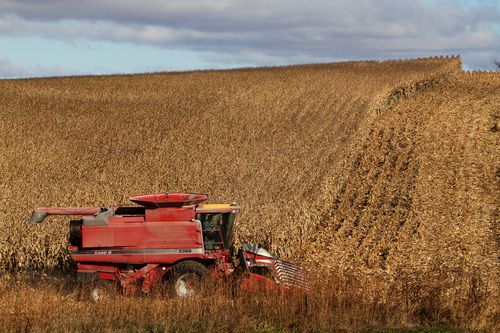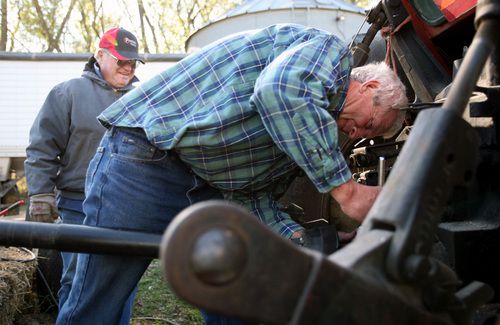“Can you watch that gate and make sure none of the cows walks through?” Mena Kaehler asked as she drove by with a bucketloader full of silage for some of the heifers and bulls on her and her husband’s 163-acre farm in St. Charles last week. It’s a little after 7 a.m. — morning chores time.
It was a reasonable request of two public radio city slickers — me and photographer Jeff Thompson — who were anxious to show our agricultural chops, minutes into spending the day with the Kaehlers in southeast Minnesota farm country.
While Thompson and I chatted at the gate, at least one heifer walked by us undetected and into the no-cow zone. The escapee was Miss Hoya Saxa, who was scheduled to be picked up in an hour or so by her new owner, having been sold at an online auction a few days ago for more than $24,000.
“No!” the anguished voice from the returning bucketloader shouted. Mena Kaehler recognized that the family’s big payday was heading for the running of the bulls, and not needing to acknowledge that public radio city slickers make lousy gate guards.
It didn’t take much for her to steer the bank account back to safer ground, and she didn’t have to tell us the lesson we just learned: Every detail matters on the farm, and inattention can cost you plenty.
Mena and Ralph Kaehler are the fifth generation of Kaehlers working this farm, and with any luck, there’ll be a sixth someday. One of their sons is working in New York, trying to get a bankroll started to buy a farm. The other is a student at Ridgewater College in Willmar. They hope to be partners one day.
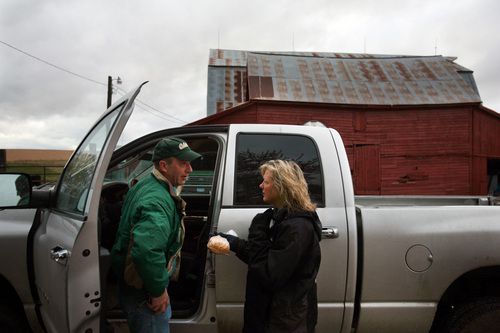 (Ralph Kaehler leaves early for a work assignment at a farm in Mabel, MN. He asks his wife, Mena, to take a corn sample to the grain elevator to have its moisture content checked.)
(Ralph Kaehler leaves early for a work assignment at a farm in Mabel, MN. He asks his wife, Mena, to take a corn sample to the grain elevator to have its moisture content checked.)
But there’s a rite of passage on the farm. “You don’t come here to get into farming,” Ralph Kaehler says. “You go somewhere else first, and then you come back.” Ralph went to Colorado to get a Masters degree, where he met Mena, and came back to Minnesota to take over his part of the farm from his mother 20 years ago. His dad died in 1984.
You also go to college. All seven children of Kaehler’s mother, Maxine, went to college. “I did it,” she says proudly when I asked her how.
“We want to be able to give them this farm; we’ve told them that from day one,” Mena says of her own sons. But, she adds, there’s no family pressure to continue the farm.
It’ll be a challenge if they do, though. The farm, on which the Kaehlers raise cattle, is small at 163 acres. “We wouldn’t be able to farm 163 acres if Ralph didn’t have an outside job, too,” Mena says. Ralph is district sales manager for Quality Liquid Feeds.
There’s little room for the expansion that keeps most farms in business by necessity. Cattle raised for breeding and beef need space, but pastureland is hard to come by these days in Minnesota.
 Mena Kaehler brings a plate of cookies to her brother in law, Ed, who is harvesting corn on property he rents from the Kaehlers
Mena Kaehler brings a plate of cookies to her brother in law, Ed, who is harvesting corn on property he rents from the Kaehlers
It’s harvest time, a chance to recalibrate the rhythm of rural Minnesota. Ralph’s brother, Ed — 12 years older — has moved his combine onto Ralph and Mena’s property. He rents the land from his brother to plant corn, and when he’s done, the Kaehlers will graze their cattle on the corn flotsam over the winter.
“You have to treat this like a business, even though family is involved,” Mena says. “And it is a business, but you still have to sit at the table at Thanksgiving.”
“Ralph got a good deal,” brother Ed says of the lease on the land from which he’s pulling a season’s worth of corn, sounding more business partner than brother.
“It’s a good time to be a farmer and anyone who says different isn’t telling the truth,” he says while waiting for the combine to disgorge its pickings into a bin that a tractor will take to a semi parked nearby, and then take it to Ed’s farm where it will be dried and stored until the price is right.
( From an office in his 1800’s farmhouse, Ralph Kaehler sells cattle to the world and manages his feed business.)
These days, the price is right. Corn is selling for nearly $6 a bushel. But farmers are as concerned about its moisture content during harvest as the price it fetches. The summer dry spell has created fairly dry corn, which should minimize the amount of time and energy required to dry it.
On this day, a computer in the combine tells Ed the corn he’s picking has 17 percent moisture content. The shipper at the river in Winona won’t accept anything over 15 percent. The ethanol plant farther away will not only take corn with a higher moisture content, it’ll pay a little more than “taking it to the river.” But the river is closer.
Details.
From his perch in the combine at the top of a hill, Kaehler can see the past and, maybe, the future. He points out four or five neighboring farms and recites the number of dairy cows each raised at one time. Then he points out the farms that still have dairy cows. He points to one farm.
People are moving out here from St. Charles and buying farmhouses. “They just want their five acres,” he says. He laments that he doesn’t know half the people who live in the county, anymore.
He says every farm used to raise at least one pig. “Now, you can’t find a pig in Winona County,” he says. Apparently, the family pig is the agricultural canary in the coal mine.
He describes a litany of challenges to farmers of smaller operations. “It’s not a fair playing field,” he says. Monsanto sells seed to larger operations at a fraction of the price it’ll sell to him and other small farms. When land comes on the market, it’s snapped up for far more than a local farmer can afford to pay.
Cropland prices are about 20 percent higher this year from a year ago, according to the Federal Reserve Bank of Chicago. When the price of corn goes up in farm country, the price of everything else goes up, too.
“The owner of that property lives in Chicago,” Ed Kaehler says, gesturing toward a neighboring field. “They can never make enough off it” considering the price paid, but with the differing tax laws, owners can write the difference off against other parts of their operations.
Ironically, those big operations might be his ticket to a nicer combine. This one — 12 years old — is reaching the end of its life. Government incentives and a big spike in the farm income have made it likely the bigger operations can afford the price of a new combine. That should lead to a glut of used combines for the smaller operation to buy.
It’s big money on the farm these days. “How do you get into farming if you don’t grow up on a farm?” I ask.
“You don’t,” Ed says.
It’s a debatable point. Earlier, Ralph Kaehler said young people willing to “start at the bottom and work their way up” on a farm can advance to managing or owning one. But that, he acknowledges, isn’t a strong suit for young people. Many employees of larger farm operations in Minnesota are recent immigrants.
Kaehler halts his combine; the semi is now full of corn and has to be taken to his farm 10 miles away. His cousin, Bob Larkin, has arrived from Redding, California to help bring in the harvest. While Kaehler waits, Larkin drives 10 miles to Eyota to unload the morning’s bounty.
Larkin, a retired truck driver, returns to Minnesota in the spring to help Kaehler plant, and in the fall to help harvest. “I have the best of both worlds,” he says. He avoids a Minnesota winter. While here, he spends a fair amount of time in the truck. If he’s not hauling corn to the dryer at Ed’s house, he’s taking it to Winona, and waiting two hours to unload it. It takes seven minutes for the ubiquitous grain trucks to unload a full load of corn if all goes well.
On this day, things don’t go well. An attachment on a tractor — called a power take off — snaps as it powers the auger, which carries the corn to a silo and dryer. Corn starts spilling everywhere.
“This is going to take longer than I thought,” Ed says after also driving the 10 miles to answer Larkin’s call for help. The harvest of 2011 grinds to a stop while he figures out what’s causing the shear bolt on the attachment to snap repeatedly.
Back at the Kaehlers, Miss Hoya Saxa has been loaded into a trailer and is on her way to her new home. Ralph, back from a morning feed tank construction job in Mabel, MN., is trying to get a veterinarian to stop by for a round of vaccinations before a cattle show at the State Fairgrounds. But eight is too much for the vet to make time for the next day. He’ll work out the details later.
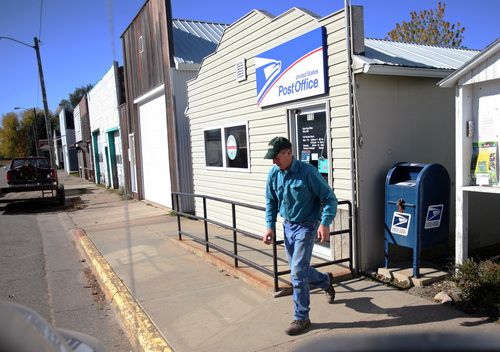 (After lunch with his wife, 90-year-old mother, and a man who has worked for the family for 43 years, Ralph Kaehler stops to mail letters in the small town of Utica, Minnesota. Many small town Post Offices are closing, but Kaehler says everyone ends up in another town everyday anyway, so he doesn’t think it’ll cause big problems )
(After lunch with his wife, 90-year-old mother, and a man who has worked for the family for 43 years, Ralph Kaehler stops to mail letters in the small town of Utica, Minnesota. Many small town Post Offices are closing, but Kaehler says everyone ends up in another town everyday anyway, so he doesn’t think it’ll cause big problems )
Kaehler is, unsurprisingly, as animated a booster of Minnesota agriculture as the state has. If there’s a conflict between the types of farming done around the St. Charles area — large, small, Amish, cattle, dairy, swine — it doesn’t show when he surveys the region.
He’s clearly proud of the good times the industry is experiencing, but mindful that there’s a yin and yang to agriculture. “It wasn’t long ago I’d get up in the morning knowing I’d make less than the day before and there wasn’t a damn thing I could do about it,” he says while driving to the giant Daley Farm of Lewiston, a family-run farm with 1,500 cows, and a stack of employment applications on a counter in the office.
He points out the environmental benefits of the large-scale operation, answering criticism of the industry not yet stated. The family has spent $1.5 million on a new technology that reclaims the bedding sand from manure from four huge barns. The cows appear to be well pampered, and a younger generation of farmer seems well established.
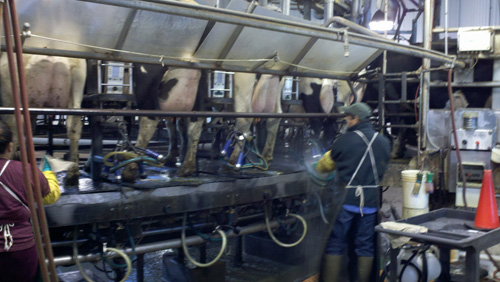 (At the Daley Farm, cows stand on a moving platform while being milked. Computers monitor the health and production of the cow.)
(At the Daley Farm, cows stand on a moving platform while being milked. Computers monitor the health and production of the cow.)
The manure lagoons at the farm are being replaced by two large ponds of mostly-liquid fertilizer that will be injected into the cropland rather than spread by tossing it through the air, as is the practice at most farms.
At the dairy where the cows are milked for all but three hours a day, the harvest ended a little more than a week ago. But it’s not shipped elsewhere. “It’s a self-sustaining operation,” Kaehler points out. Most of what the cows eat is grown on the property, which is picture tidy and oozes “professional.”
Throughout the valley, there’s a “newness” surrounding agriculture. Across from the Kaehlers, Twin Valley Ag Coop has opened a gleaming new grain elevator and farm services facility. Its owners — farmers — deemed the time right to move from downtown. In Utica, the old grain elevator with its traditional Purina Checkerboard Square sign has been replaced by a more modern facility. The farm implements dealer appears to be selling and the sheen on the valley proclaims that while the rest of the nation’s economy tanks, this is agriculture’s time.
 Kaehler seems to know everybody in St. Charles, Lewiston, and nearby Utica, all stops during his day. He knows Fidel Castro, too, and may be the only person ever to upstage Jesse Ventura. During a trade mission, the then-governor played second fiddle to Kaehler and his family while negotiating to sell beef to Cuba.
Kaehler seems to know everybody in St. Charles, Lewiston, and nearby Utica, all stops during his day. He knows Fidel Castro, too, and may be the only person ever to upstage Jesse Ventura. During a trade mission, the then-governor played second fiddle to Kaehler and his family while negotiating to sell beef to Cuba.
Farming and politics are often joined at the hip. As darkness falls, lights of the combines dot the black fields along U.S. 14. Mena Kaehler is driving to Winona for a meeting of the Winona County Planning Commission, which is holding a public hearing on frac sand mining. Ralph is off to a Farm Bureau meeting.
Mena isn’t planning to say anything at the hearing, but she’s the chairperson of the Winona County Board of Commissioners and there’s a fair chance she’ll have to decide on a proposed moratorium in a matter of weeks.
By close to 10 p.m., the commission still has only tackled one of the three proposals when it takes a break. She notices commission members are stocking up on rations of Mountain Dew and figures it’ll be a long night before the next early morning on the farms of Winona County, where the harvest doesn’t sleep in.

